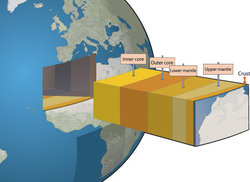Continent
|
|
A continent is a large continuous land mass. The world was first divided into continents by the geographers of Hellenistic Alexandria. Taking Alexandria as a prime meridian, they divided the oikoumene or habitable earth into three parts: Asia was east of Alexandria, Europe was west of Alexandria and north of the Mediterranean Sea, and Libya, known by the Romans as Africa, was west of Alexandria and south of the Mediterranean.
Geologically, the surface of Earth consists of many tectonic plates. Some of them are continental plates, largely covered by thick, relatively light metamorphic and sedimentary rock such as granite which floats on the Earth's mantle, and much of which is visible as dry land; and the rest are oceanic plates, consisting of a thin basaltic layer of solidified mantle, and covered by a sea punctuated with basaltic volcanos. There are six large continental plates, which give the following geologically recognized continents, from the largest to the smallest:
- Eurasia mostly on the Eurasian Plate
- Africa on the African Plate
- North America mostly on the North American Plate
- South America on the South American Plate
- Antarctica on the Antarctic Plate
- Australia on the Australian Plate
Geographers and historians find it useful to define larger land masses connected with a land bridge:
- Africa-Eurasia: the combined land mass of Africa and Eurasia
- The Americas (or America): the combined land mass of North America and South America
Africa-Eurasia is less commonly defined than the Americas. These land masses are usually considered supercontinents rather than continents, though.
Because of the perceived cultural differences by the inhabitants, it is conventional to subdivide Eurasia into Europe and Asia. They are more appropriately called regions, and neither is a geological or geographical continent. In the same manner, historians may subdivide Africa-Eurasia into Eurasia-North Africa and Sub-Saharan Africa.
These definitions give the following alternate models:
- 7 regions: Europe, Asia, Africa, North America, South America, Antarctica, and Australia.
- 6 regions: Europe, Asia, Africa, America, Antarctica, and Australia.
- 5 continents: Eurasia, Africa, America, Antarctica, and Australia.
- 4 continents: Afrasia, America, Antarctica, and Australia.
The 7-region model is usually taught in the United States, Canada and Australia, while the geological 6-continent model is taught in East Asia. In Europe and Latin America including the United Kingdom and Mexico, they teach the 6-region model, which is shown in the Olympic Games flag as five rings, excluding Antarctica.
During the ice age, the supercontinent of Africa-Eurasia and the Americas was formed, connected with the Bering Land Bridge. Another land bridge connected Australia and New Guinea then, and they formed the continent of Sahul. This can give the following 3-continent model of the ice age: Africa-Eurasia-America, Sahul, and Antarctica.
Continents are sometimes subdivided to make subcontinents, which term is even less precisely defined than continent itself.
Islands are usually considered to belong geographically to the continent they are closest to, and hence the British Isles are considered to be a part of Europe. The Pacific islands may be associated with Australia to form the region of Oceania or may not be associated with any continent. You may also find the term Australasia and Sahul.
When the Continent is referred to without clarification by a speaker of British English, it is usually presumed to mean Continental Europe, i.e., Europe, explicitly excluding Great Britain and Ireland. The Continental United States excludes Hawaii and sometimes Alaska (in the latter case it is synonymous with Contiguous United States).
See also List of countries by continent, Satellite Images of Continents.
Geology
During the 20th century, it became accepted by geologists that continents move location on the face of the planet over the geologic timescale, a process known as continental drift, explained by the theory of plate tectonics. It is the tectonic plates that have drifted, broken apart and joined together over time to give rise to the continents we now recognize. Consequently, in the geological past and prior to the present continents, other continents existed.
Although from a human perspective shallow inland seas such as the Bering Sea appear to divide up land masses into continents, such ephemeral features do not define continents geologically. A geologic continent is a continuous piece of continental crust. As such, Laurasia (North America-Eurasia) and Africa-Arabia are one continent, which for the past three million years has been linked to South America as well. This world-spanning land mass has no name except for the Classical meaning of "The Continent". The other large geologic continents are Sahul (Australia-New Guinea) and Antarctica, but there are many microcontinents as well: Madagascar, the Seychelles (or, more accurately, the Mascarene Plateau), New Zealand, New Caledonia, etc., which are splinters off the ancient continent of Gondwanaland. Note that volcanic Iceland is an exposed bit of oceanic crust, and therefore not a microcontinent. Likewise, the British Isles, Sri Lanka, Borneo, and Newfoundland are integral parts of the Laurasian continent which are superficially separated by the inland seas flooding its margins.
Geography Clipart and Pictures
- Geography Clipart (https://classroomclipart.com/image/category/geography-clipart.htm)
- Map Clipart (https://classroomclipart.com/image/category/maps-clipart.htms)
- Geography Pictures (https://classroomclipart.com/image/category/geography-photos.htm)


